Here at Park Lore, we’re all about discovering the stories behind the rides; the “what, where, who, when, why, and how?” of the most incredible attractions across the theme park industry. Our deep dives into the making of the classics we know and love has created a go-to library of Lost Legends, Modern Marvels, Declassified Disasters, and unbuilt Possibilitylands, with features focused on some of the best and worst rides ever to exist.
Recently, our longtime friends at FastpassFacts took a look at some of fans’ favorite, most-missed EPCOT attractions – an awesome glimpse back into some of the ’80s originals that made Disney World’s second park so different from anything before or since…
(INSERT VIDEO HERE)
… But the past is only part of the story! With FastpassFacts’ video as part one, we want to wrap up the tales of these closed classics by exploring what happened to them after their closures. You may already know what became of each of these rides, but do you know how they got there? Let’s take a look at the “after” of each of these legend-status rides…
What happened to EPCOT’s classic rides after their retirements? You may know the end result, but today, we’ll dig deep to figure out how each transformation came to be…
1. World of Motion -> TEST TRACK

Though it may have been overshadowed by some of EPCOT Center’s signature dark rides, there’s no doubt that World of Motion was special. Sure, like other Future World staples, it was a journey through the story of human innovation – in this case, transportation. But World of Motion benefitted from the work of two legendary Disney animators-turned-Imagineers, Marc Davis and Ward Kimball, who added humor and stylization to the ride, watching humans discover “animal power,” then the wheel, then wagons, then bikes, then cars, then trains, then planes, and onto the future.
When auto manufacturer General Motors’ option to renew its sponsorship in EPCOT came due in 1992, it happened to coincide with a reported $23.5 billion loss for the company – the largest fiscal year write-off of any corporation in American history to that time. Shuttering 21 manufacturing plants and laying off 70,000 workers, General Motors was in no place to dump another decade of support into an aging showcase of humanity’s history at Disney World.
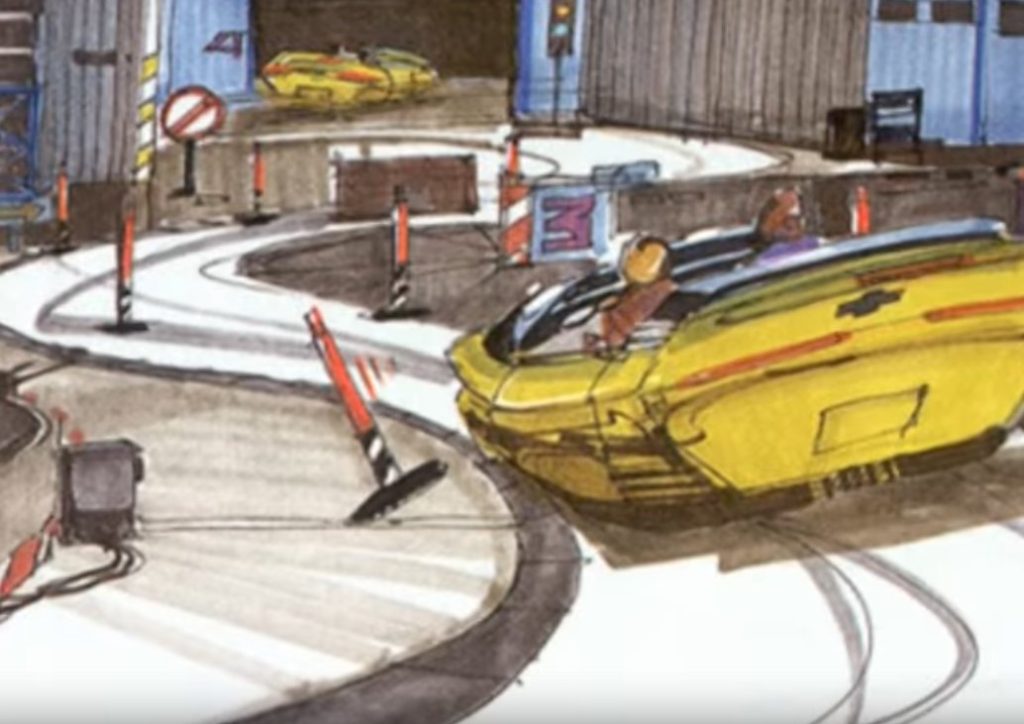
The automotive giant did agree to support the park on a trial, year-by-year basis, but insisted that if Disney wanted another long-term sponsorship agreement, they needed to come up with a new attraction that spotlighted General Motors and “sell” their cars.
Turning to the archives, Imagineers pulled images and ideas drawn up during a visit to GM’s Proving Grounds in Milford, Michigan – where new car concepts are “put through the paces” and subjected to high speeds, extreme weather, and various surface conditions meant to test vehicles’ road-readiness. With modern ride technology, it was more possible than ever… World of Motion closed forever on January 2, 1996.
At the 1997 Chicago Auto Show, General Motors and Disney were on hand to announce a new ride called TEST TRACK. The “behind the scenes look at the thrill of automotive safety” was explained by General Motors as an opportunity to market not just its safety practices, but its new vehicles to Disney’s international clientele – to their thinking, a real win-win among sponsorshop deals. Though it took $100 million and two years of delays, Test Track officially opened March 17, 1999.
After queuing in an industrial factory of car parts, gadgets, and safety diagrams, guests were escorted to the loading zone. Taking the seats normally filled by test dummies, riders were whisked up to the second story of the pavilion, where World of Motion had been hollowed out. High speed braking, rumble strips, hot and cold temperature durability, handling, and manueverability were all put to the test, culiminating in the ride’s starring moment: its giant “slot cars” accelerated from 0 to 65 miles per hour, bursting into an outdoor speed course for a run around the property.
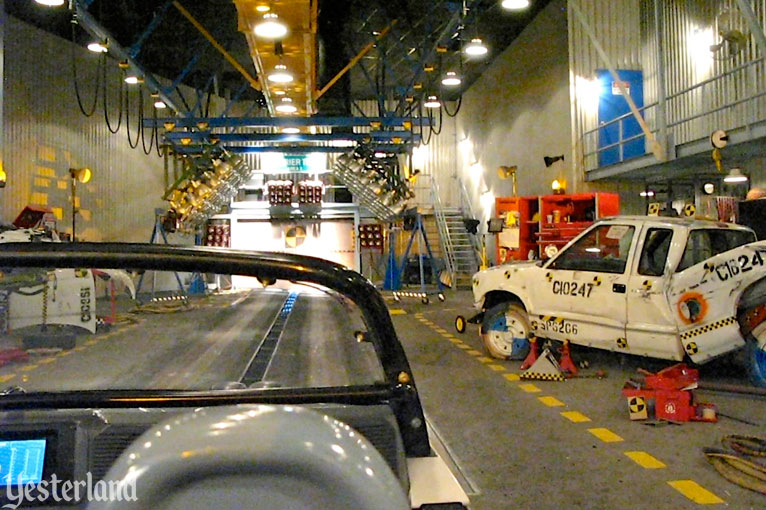
TEST TRACK wasn’t just a success – it was a colossal hit, ushering in an era of semi-scientific, technological thrill rides, replacing the lengthy, informative dark rides of old one by one by one… including a fully “upgraded” aesthetic and retheme to TEST TRACK itself after just over a decade of life!
Park Lore is all about digging deep, so if you want to read the full story of EPCOT’s transportation pavilion, make the jump to our History in Motion – Part I: World of Motion, and Part II: TEST TRACK.
2. Horizons -> Mission: SPACE
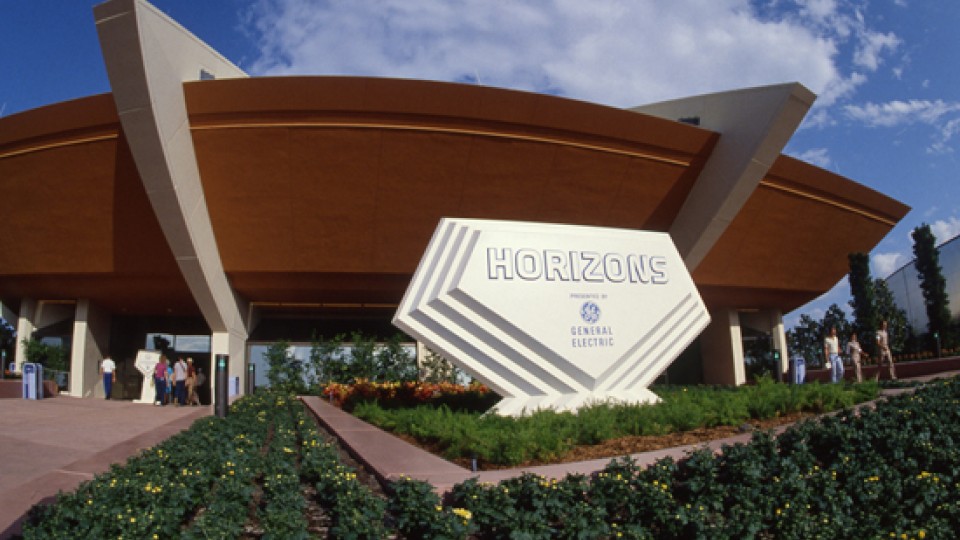
Horizon’s is often celebrated as the keystone of EPCOT Center and its Future World. Whereas each pavilion in Future World focused on the past, present, and future of single area of science and industry (like the land, the seas, energy, communication, or transportation), Horizons the test at the end of the unit – the story of what could await for humanity in the 21st century if we successfully harnessed the topics of the other pavilions.
On board, guests sat in suspended Omnimovers and set course for the future. A “sequel” to the Modern Marvel: Carousel of Progress (also sponsored by General Electric), Horizons toured guests through the lives of the Carousel family’s children, who had migrated to new human colonies like the Sea Castle ocean base, Mesa Verde desert farm, and Alpha Centuri space station. The ride also included an opening scene using massive, domed, Omnimax screens, and a finale in which guests could “choose their future” using in-vehicle buttons to vote for one of three film-based finales.
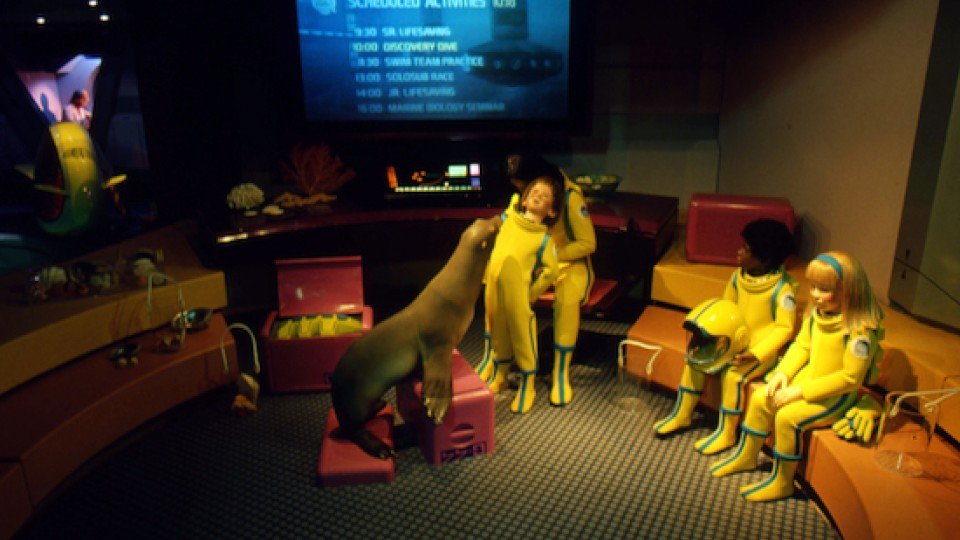
The ’90s saw the closure of nearly all of Future World’s dark rides, and Horizons was no exception. The ride was mothballed in December 1994 – not coincidentally, a year after the sponsorship of General Electric lapsed. Weirdly, Horizons re-opened a year later… but only because the delay to the under-construction TEST TRACK and the conversion of Universe of Energy (see the next page) meant that EPCOT’s already-pathetic ride count was reduced by two, and Horizons’ capacity was needed.
Once TEST TRACK was ready, Horizons was able to close for good – January 9, 1999. The building was demolished altogether in summer 2000.
Disney had been toying with the idea of a pavilion themed to space since the park’s earliest concepts (and in fact, concepts had even been drawn up for re-using Horizons’ structure to house a space-themed ride in the ’90s). But just as Horizons had been the keystone of an intellectual EPCOT Center of the ’80s, a new ride concept offered to become the unquestioned headliner and anchor attraction of a thrill-focused, scientific EPCOT of the 2000s.
Costing $100 million, MISSION: SPACE opened in August 2003. The ride is comprised of four massive centrifuges, each holding 10 simuator pods. Four guests load into each pod, where parallax screens simulated a journey to Mars. Each pod is capable of its own simulation (rocking and leaning) while the centrifuge itself spins, producing 2.5 Gs of force. But unlike a roller coaster where a weightless crest of an “airtime hill” or the in-seat pressure of a loop are momentary, the spinning centrifuge produces sustained G-force.
It’s not just that Mission: SPACE is dizzying, disorienting, and intense as your eyes and mind battle over the motion they’re experiencing; it’s that it produces a sensation you won’t find on any other ride, in any other amusement park. Because it’s hard to describe, it’s hard to convey to potential riders that Mission: SPACE is a physically demanding experience, far and above other “ride restrictions” you’ll find on Big Thunder Mountain or Space Mountain or Rock ‘n’ Roller Coaster or Dinosaur.
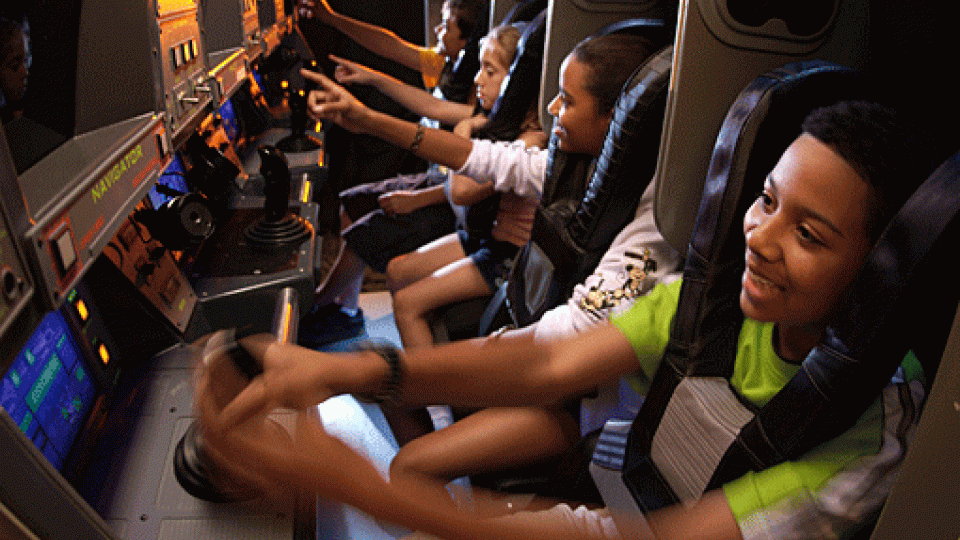
Warnings throughout the queue are numerous and intentionally intimidating, warning guests not to lean forward, not to close their eyes, and to only look straight ahead and never to the side or risk needing to use the provided “barf bags.” Numerous guests have been transported to local hospital after riding (most reporting nausea or chest pain), and sadly, two have died due to pre-existing conditions that were aggravated by the experience.
Once upon a time, Disney envisioned Mission: SPACE as a highly franchisable attraction that would debut at EPCOT, but then quickly be duplicated in the Tomorrowlands of Anaheim, Tokyo, Paris, and Hong Kong. Instead, the ride has necessitated major work. In 2006, two of the four centrifuges were been switched to a less intense “Green Mission” that doesn’t include the spinning-induced G’s. (If Disney had known, they probably wouldn’t have paid for four multi-million-dollar centrifuges.) Far from being EPCOT’s headliner, it seems unlikely that another Mission: SPACE will ever be built, only worsening the pain felt by the loss of Horizons.
Read the full story of EPCOT’s Horizons here.
And that’s not all… Continue onto the next page to learn more about what, why, and how several other classic attractions became something new…

